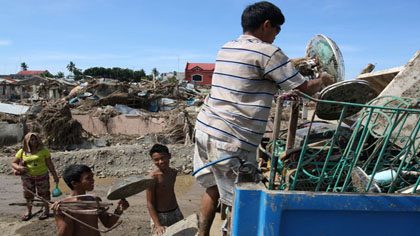SUMMARY
This is AI generated summarization, which may have errors. For context, always refer to the full article.

MANILA, Philippines – If a flood induced by a storm like Sendong inundates your home, the first thing to do is to save your family. Then, salvage your appliances. But which appliances first?
Juanito Zurbano, a technician from flood-prone San Mateo, Rizal, said that saving appliances with lenses or data readers (like DVD players, over simpler machines like TV sets or refrigerators) should be prioritized.
Zurbano, who has repaired home appliances for over two decades, described machines with lenses as highly sensitive.
“’Pagka nabasa ’yon – minsan nga, maski natuluan lang ng pawis – masisira eh. Eh ’yun pa, nalubog pa sa baha,” Zurbano said, when damages as of Wednesday, December 21, due to Sendong rose to almost P1 billion. (If they get drenched – or sometimes, even wet with only drops of sweat – they get damaged. All the more if they get submerged in floodwaters.)
The latest report from the National Disaster Risk Reduction and Management Council as of Thursday, Dec 22, said 1,010 have died; 1,603 were injured; 51 are still missing.
DVD players are unlike most TV sets that rely on a non-computerized cathode ray tube, a component made of a heated filament inside a glass tube that creates a vacuum, according to Discovery Channel’s online resource HowStuffWorks.
With laser and lens systems serving as data readers, DVD players involve “a good bit of computer technology,” says the site.
‘Impractical’ DVD repairs
Zurbano finds it impractical – even costlier – to repair DVD players because replacement lenses would have to be ordered from manufacturers. When customers came to him in droves after tropical storm Ondoy inundated their homes in 2009, the technician said the same thing.
Zurbano’s own appliances were likewise damaged after Ondoy submerged his San Mateo residence, along with portions of Marikina City, after the Marikina River overflowed unexpectedly.
“Kung magagawa man, mahal na. Bumili ka na lang ng bago. Eh mahal ang piyesa (If an appliance can still be repaired, it would be costlier. Better to buy a new one),” he said.
Depending on the type, DVD lenses could cost anywhere between P110 to P480 each, excluding labor which Zurbano pegs at around P400, at least in his repair shop. On the other hand, one can buy a DVD player for as low as P1,390.
In the case of TV sets, water is least likely to seep into and damage cathode ray tubes because these are vacuums, Zurbano said.
He said the TV component most at risk is the capacitor, a device that stores electric charges. One can easily wash it, however, to remove mud and dirt from floodwater and prevent the capacitor from gathering rust, the technician said (See tips below).
‘Many can be salvaged’
In its briefer titled, “How to Salvage Flood-Damaged Appliances,” Kansas State University also said many flood-damaged appliances like refrigerators can still be salvaged.
These appliances, however, “must be thoroughly dried out first and should be checked out by an authorized service technician before being plugged into an electrical outlet,” the briefer says.
“Cleaning and sanitizing should probably await the electrical check – it may not be worth the time to clear up the unit. Move the appliance to a location where air can get to it and prop the doors open. You may want to set a fan inside or nearby to increase the airflow,” the briefer says. The drying process could take a week or more.
Other tips from Zurbano and the KSU briefer include the following:
–If you anticipate floodwater entering your house, switch off your main electric switch to avoid short circuits.
–Once floodwaters subside, unscrew the lid of each electric socket that was submerged, then clean its interior using water and a brush, and allow it to dry. Mud mixed with water takes a longer time to dry, and could cause short circuits that might eventually lead to fire. Meanwhile, mud that dries up inside a socket could block the flow of electricity and render the socket useless.
–Unscrew and open appliances that got wet so they could be cleaned. To be safe, seek the help of a technician for this.
–Do not simply hose down your mud- and water-filled appliances because water “may get into places that flood didn’t reach, and you will only increase the damage.” Instead, wash these with wet cloth and common household cleaners, and rinse these with a disinfectant solution made of a teaspoon of chlorine bleach for each gallon of water. Then dry the objects with a towel. This will sanitize the appliances and prevent mildew (KSU).
–To get rid of odors, wash the appliances with a solution consisting of a teaspoon of baking soda mixed with a quart of water, or a cup of vinegar or household ammonia mixed with a gallon of water. Activated charcoal, which is usually available in pool or aquarium supplies shops, could also absorb persistent odors (KSU).
Despite these measures, however, one cannot expect appliances that got soaked in floodwaters to remain in perfect shape, Zurbano said. They are likely to malfunction in the future, he added. – Rappler.com
Add a comment
How does this make you feel?
There are no comments yet. Add your comment to start the conversation.